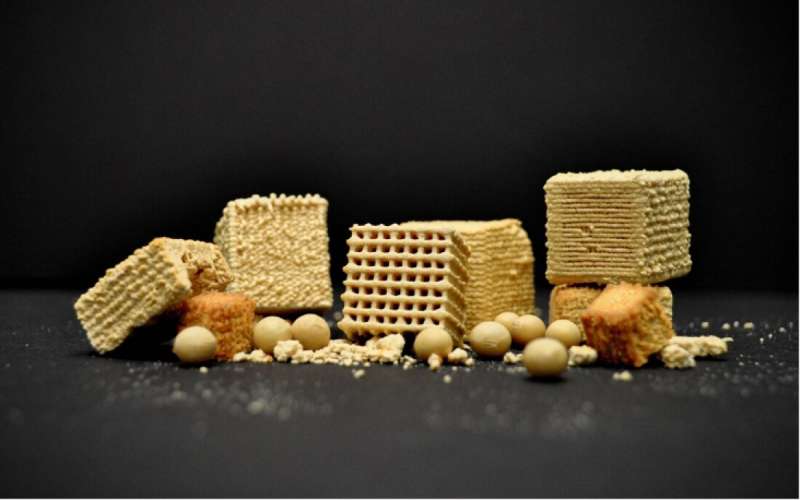Simple method to upcycle okara using 3D printing

Researchers from the Singapore University of Technology and Design (SUTD) developed a method to perform direct ink writing (DIW) 3D printing of okara—a soybean byproduct generated from the production of soy milk and bean curd—without using food thickeners. Despite the high amount of dietary fiber and protein present, okara is usually discarded during the food manufacturing process. The researchers used 3D printing to repurpose otherwise discarded okara powders to create snacks with controlled texture.
3D printing has been an emerging technology to create food in various shapes designed using computers. During this process, food additives (usually hydrocolloids and food thickeners) are added to food to enable 3D printing and maintain the printed structures. The use of additives may, however, cause unintended changes in the texture and flavor of the original foods.
To overcome this challenge, the research team from SUTD's Soft Fluidics Lab identified the specific particle size and concentration of okara that achieve desired food ink properties to ensure 3D printability. Their measurements suggested that the particle sizes were an essential variable to determine the rheological properties of the okara ink. Characterisations of the formulated okara ink were conducted to analyze their rheological and textural properties.
"Our demonstration highlights the upcycling of otherwise wasted foods to achieve customized textural properties via 3D printing. We believe our current demonstrations pave the way to realize the full potential of 3D printing technology toward improved food design and sustainability," explained Associate Professor Michinao Hashimoto, the principal investigator of the study from SUTD.
"The adequate use of such underutilized nutritious food would promote food supply sustainability and food waste reduction. We plan to develop more inks formulated with other food wastes to boost sustainability, " added lead author and Ph.D. candidate from SUTD, Mr Lee Cheng Pau.
More information: Cheng Pau Lee et al, 3D Printing of Okara Ink: The Effect of Particle Size on the Printability, ACS Food Science & Technology (2021). DOI: 10.1021/acsfoodscitech.1c00236





















